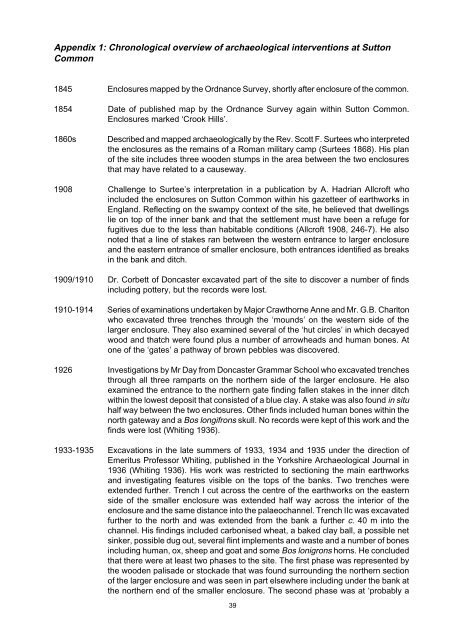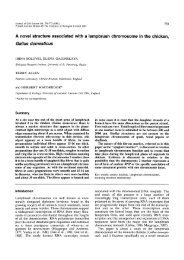Sutton Common Updated project design - University of Exeter
Sutton Common Updated project design - University of Exeter
Sutton Common Updated project design - University of Exeter
Create successful ePaper yourself
Turn your PDF publications into a flip-book with our unique Google optimized e-Paper software.
Appendix 1: Chronological overview <strong>of</strong> archaeological interventions at <strong>Sutton</strong><br />
<strong>Common</strong><br />
1845 Enclosures mapped by the Ordnance Survey, shortly after enclosure <strong>of</strong> the common.<br />
1854 Date <strong>of</strong> published map by the Ordnance Survey again within <strong>Sutton</strong> <strong>Common</strong>.<br />
Enclosures marked ‘Crook Hills’.<br />
1860s<br />
Described and mapped archaeologically by the Rev. Scott F. Surtees who interpreted<br />
the enclosures as the remains <strong>of</strong> a Roman military camp (Surtees 1868). His plan<br />
<strong>of</strong> the site includes three wooden stumps in the area between the two enclosures<br />
that may have related to a causeway.<br />
1908 Challenge to Surtee’s interpretation in a publication by A. Hadrian Allcr<strong>of</strong>t who<br />
included the enclosures on <strong>Sutton</strong> <strong>Common</strong> within his gazetteer <strong>of</strong> earthworks in<br />
England. Reflecting on the swampy context <strong>of</strong> the site, he believed that dwellings<br />
lie on top <strong>of</strong> the inner bank and that the settlement must have been a refuge for<br />
fugitives due to the less than habitable conditions (Allcr<strong>of</strong>t 1908, 246-7). He also<br />
noted that a line <strong>of</strong> stakes ran between the western entrance to larger enclosure<br />
and the eastern entrance <strong>of</strong> smaller enclosure, both entrances identified as breaks<br />
in the bank and ditch.<br />
1909/1910 Dr. Corbett <strong>of</strong> Doncaster excavated part <strong>of</strong> the site to discover a number <strong>of</strong> finds<br />
including pottery, but the records were lost.<br />
1910-1914 Series <strong>of</strong> examinations undertaken by Major Crawthorne Anne and Mr. G.B. Charlton<br />
who excavated three trenches through the ‘mounds’ on the western side <strong>of</strong> the<br />
larger enclosure. They also examined several <strong>of</strong> the ‘hut circles’ in which decayed<br />
wood and thatch were found plus a number <strong>of</strong> arrowheads and human bones. At<br />
one <strong>of</strong> the ‘gates’ a pathway <strong>of</strong> brown pebbles was discovered.<br />
1926 Investigations by Mr Day from Doncaster Grammar School who excavated trenches<br />
through all three ramparts on the northern side <strong>of</strong> the larger enclosure. He also<br />
examined the entrance to the northern gate finding fallen stakes in the inner ditch<br />
within the lowest deposit that consisted <strong>of</strong> a blue clay. A stake was also found in situ<br />
half way between the two enclosures. Other finds included human bones within the<br />
north gateway and a Bos longifrons skull. No records were kept <strong>of</strong> this work and the<br />
finds were lost (Whiting 1936).<br />
1933-1935 Excavations in the late summers <strong>of</strong> 1933, 1934 and 1935 under the direction <strong>of</strong><br />
Emeritus Pr<strong>of</strong>essor Whiting, published in the Yorkshire Archaeological Journal in<br />
1936 (Whiting 1936). His work was restricted to sectioning the main earthworks<br />
and investigating features visible on the tops <strong>of</strong> the banks. Two trenches were<br />
extended further. Trench I cut across the centre <strong>of</strong> the earthworks on the eastern<br />
side <strong>of</strong> the smaller enclosure was extended half way across the interior <strong>of</strong> the<br />
enclosure and the same distance into the palaeochannel. Trench IIc was excavated<br />
further to the north and was extended from the bank a further c. 40 m into the<br />
channel. His findings included carbonised wheat, a baked clay ball, a possible net<br />
sinker, possible dug out, several flint implements and waste and a number <strong>of</strong> bones<br />
including human, ox, sheep and goat and some Bos lonigrons horns. He concluded<br />
that there were at least two phases to the site. The first phase was represented by<br />
the wooden palisade or stockade that was found surrounding the northern section<br />
<strong>of</strong> the larger enclosure and was seen in part elsewhere including under the bank at<br />
the northern end <strong>of</strong> the smaller enclosure. The second phase was at ‘probably a<br />
39
















